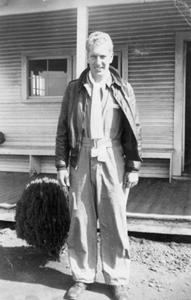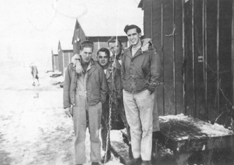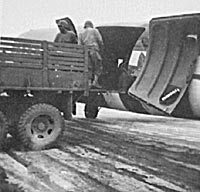
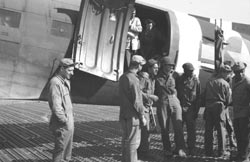
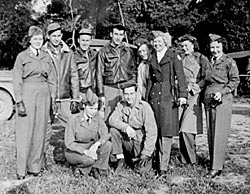
Support Units
Click here to return to the Ramsbury Airfield page
814th Air Evacuation Squadron
This unit consisted of six officers, 61 enlisted men and 25 female nurses under the command of chief nurse Captain Jane Mobely. During February 1944 the squadron, together with several thousand other US soldiers, made a fast 5 day crossing of the Atlantic aboard the Queen Elizabeth. Following the ship's arrival in Britain the squadron was sent to Fulbeck in Lincolnshire where it was attached to the 435th TCG. In April the 814th was transferred to Ramsbury and joined the 437th TCG.
The nurses, like all US aircrew, received flight pay. However, to qualify for this extra money each of them had to log 40 hours flight time per month. Pilots from the 437th Group would let the nurses fly with them on training missions, many of which were conducted at night. Sometimes the nurses were given the opportunity to fly in gliders. Clemetta Evenson, a nurse stationed at Ramsbury during 1944 had about four glider rides "It was quite an experience, all you could hear was the wind whistling over the wings".
During the weeks following the Normandy invasion each nurse had to be ready at 6 am every morning to fly out to France in order to pick up wounded troops. Sometimes they would find themselves waiting about on the flight line for hours on end, sometimes they never took off at all. Clemetta Evenson recalls "In July we went to St Lo and Omaha beach. Soon we were visiting a different place on almost every flight because of the rapidly expanding front line. If we didn't have any patients to bring back the pilots would buzz the farmer's fields on the way home. One time we were flying down a river valley and were below the tops of the trees and on another occasion buzzed a haystack and returned with hay stuck in the planes wheels!"
On outward missions from Ramsbury to the Continent the group's aircraft would carry supplies such as ammunition, food rations, fuel or medical equipment. As each aircraft landed in France it was quickly unloaded and made ready to receive wounded troops for the return trip. Each C-47 was fitted with 36 special brackets that were designed to carry 18 stretchers. On the outward leg the brackets were folded back against the inside of the fuselage but for the return they were deployed into a horizontal position. Once placed on the brackets each stretcher was held securely in place by toggle clamps.



Above
left: Supplies being unloaded from a 437th TCG
C-47 by coloured US soldiers at a forward airstrip in Normandy (Mrs C Evenson).
Above centre: Normandy casualties about to board a C-47 in perpetration
for the trip back to England. Note the two nurses (J Antrim).
Above right: Nurses and male friends at Ramsbury. The nurses are
from left to right: Clemetta Evenson, Lois Bebout, Jane Mobely (Chief Nurse),
Bertha Ellison, Merle Berns and Ruth Kruger (Mrs C Evenson).
69th Station Compliment Squadron
This unit was made up of 118 personnel who worked in such diverse trades as radio operators, aircraft mechanics, switchboard operators, motor mechanics, etc. The squadron was divided into different sections such as chemical or gas defence, post office, motor pool or flying control.
Perhaps the
69th's most high profile function was in the last named area where members of
the squadron manned the control tower and the chequered van that guarded the
approach to the runway in use. During the early months of 1944, when attacks
by German aircraft were still a real threat, aircraft wishing to takeoff or
land were always told by the tower to "take a green light from the caravan".
There was a direct telephone link between the tower and the van and with the
two working in unison this provided safe and efficient control of ground and
air traffic at Ramsbury airfield.
Adjacent to the control room in the tower was a map room. This room held, for the benefit of pilots, a catalogue of up to date information about weather and airfield conditions across the whole of the United Kingdom.
Another of the squadron's duties was to maintain the emergency flare path (portable battery lights or goose neck flares) which were laid along the edge of the runway each night to be used in the event of a power failure. During 1944 Mr Gerald Theis from Minnesota was a Corporal with the 69th Squadron. He was often based in the control tower area and one of his daily tasks was to lay out the flare path. He was also responsible for maintaining and using the signal rockets and flare pistols which were fired into the air as a visual signal to pilots trying to land at Ramsbury in bad weather. The rockets were fired from mortars normally stored under the balcony of the control tower.
Airfield Control Caravan. This vehicle was made by 437th TCG mechanics from an old CG4A glider body with the nose and tail sections removed. It was painted in a distinctive black and white chequered pattern so it could be easily seen, and on top of the caravan was a Plexiglas dome. Gerald Theis, an airfield control operator, recalls working in the van, "Inside, a platform had been constructed so that we could sit and see out of the dome. Here we would write down the last three digits from the tail numbers of every aircraft that took-off or landed at Ramsbury. We were provided with a phone and a battery powered radio to keep in contact with the tower. There was a phone connection at the end of each runway and every time we changed landing directions we had to move the van and reconnect the phone line. When the weather was nice we would sit at a table outside!"
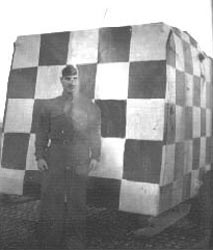
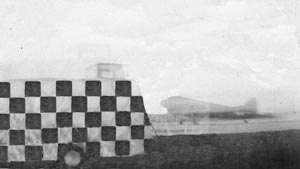
Above
left: Sgt. Russell Kane from the 69th Squadron
standing in front of the caravan at Ramsbury. Note the glider skids (William
Ladwig).
Above right: When the 437th moved to Coulommiers France in February
1945, the caravan followed and Jerry Theis took this picture there during the
summer of the same year. (G. Theis)
Below Left: Corporal Gerald Theis standing in front of a storage building near the control tower. Below Right: The same building as it looked in June 2003.
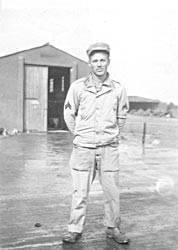
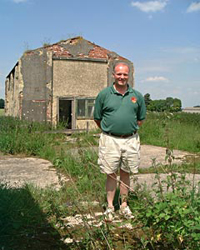
Below: Three pictures kindly provided by Mr Bill Ladwig showing 69th SCS personnel at work. From left to right:- Cpl. Jack Mazellan (note 69th SCS markings on the trucks bumper); Sandy and Sgt. Don Winkelbauer sitting on a Harley Davidson motor cycle. The wooden hut in the background was used as an office and was made from an old glider crate; Sgt. Walter Brazauskas at the wheel of an airfield gasoline tanker.
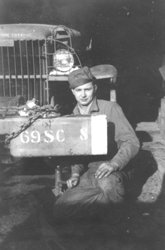
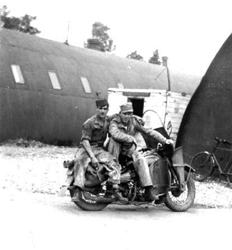
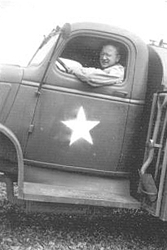
Below:
Members of the 69th SCS pictured at Ramsbury on a cold frosty winter's day.
They are from left to right:- S/Sgt. Frank Radebaugh, Pfc. Harold Swartzmiller,
Pfc. Billy Briggs (Little Tex.), Cpl. James Whiffen, Pvt Paul Hayes, Cpl. Jack
Mazellan, Pfc. James Chesnut,
Pfc.
William Ladwig, Pfc. Carl Ellard, Sgt. Joseph Lipsiea (W. Ladwig).
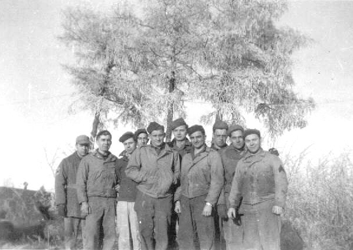
The following personnel from the 69th SCS served as mechanics at the base motor pool:- Sgt. Vernon Holmes, Sgt. Joseph Lipsiea, Cpl. Jack Mazellan, Cpl. Elward Umphfres and Pfc.William Ladwig. S/Sgt. Frank Radebaugh was in charge of the pool which maintained a variety of vehicles including two-and-a-half ton GMC 6x6s, one-and-a-half ton trucks, command cars and Jeeps.
Below
left: From left, Unknown, Cpl. James Wiffen (in window) Cpl. Elward 'Big
Tex' Umphfres. Below centre: From left, Cpl. Jack Mazellan, Sgt.Vernon
Holmes (besides being a mechanic Holmes was the 69th Squadron barber in his
spare time) and Pfc. William Ladwig.
Below right: Cpl. Jack Mazellan inspecting the underside of a Dodge truck.
(All pictures W. Ladwig)
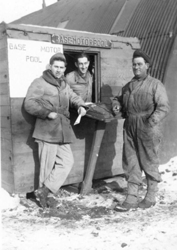
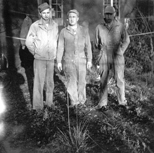
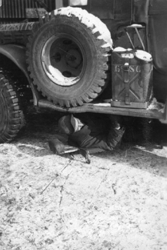
.
337th Service Squadron
During the latter part of 1943 the 337th Service Squadron left New York harbour aboard the SS Slauterdyke bound for Britain. After a very rough crossing of the north Atlantic the ship entered the Firth of Clyde and docked at the Scottish port of Glasgow. The squadron then boarded a train that took it south to a holding base near the village of Long Eaton in Derbyshire. The squadron was eventually assigned to the 437th TCG and arrived at Ramsbury airfield during the early weeks of 1944.
The 337th's task was to provide the 437th TCG with aircraft maintenance skills that were beyond the group's normal capabilities. For example; Major component replacement, battle damage repairs, glider assembly and recovery, fitting of self sealing fuel tanks and the salvage of crashed aircraft.
The squadron was equipped with four mobile recovery units. These were GMC trucks that had been modified by the addition of a front mounted crane jib. Each vehicle also carried a generator, a compressor and specialist tools. Some of the wrecks described in the aviation archaeology section of this web site were salvaged by the 337th Service Squadron.
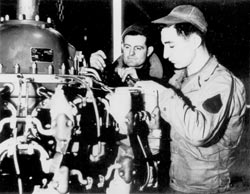
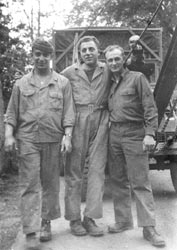
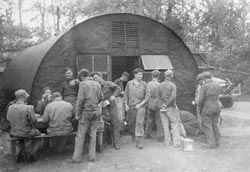
Above
left: S/Sgt. Don Ferriolo (right) and S/Sgt. Richard
Sears working on a R-1830 engine from a C-47 aircraft.
Above centre: Motor pool drivers standing in front of a mobile
recovery unit. From left to right: Cpl West, Cpl Quattrone and Cpl Hall.
Above left: A beer party in session near one of the squadron's
Nissen huts at Ramsbury. Note mobile unit to right of hut. (All three pictures
D. Ferriolo)
1455 Ordnance Medium Maintenance Company
I know very little about this unit. If any reader can provide more information about the workings of this company I would be delighted to hear from them. The photographs below have been kindly sent by Christine Aston whose father, Richard Gardner, worked on machine maintenance for the 1455th Ordnance Company. Christine is keen to correspond with anybody who knew her father during his wartime service. The company sailed from New York aboard the Queen Mary during the early weeks of 1944. They docked in Britain at Greenock, Scotland before moving to Frobrisher Hall near Colchester in Essex. The unit was then assigned to the 437th TCG and arrived at Ramsbury sometime during February 1944. The 1455th spent two Christmases at Ramsbury before moving to Coulommiers, France.
Can anybody identify the men shown in the three photographs below?
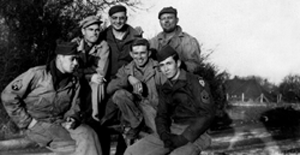
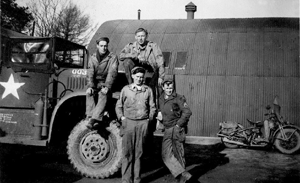
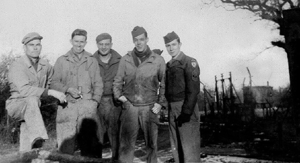
Below left: A 48 hour pass did not give much time for sight seeing,
but despite this many GIs were able to visit some of England's more famous places
of interest. Here men from the 1455th Ordnance Company peer through a locked
gate at Warwick Castle.Below centre: The same group enjoying a
meal at the Swan's Nest Hotel in Stratford-upon-Avon. Below right:
Kenilworth Castle in Warwickshire was another popular destination on the GI
Tourist Trail. (All pictures Mrs C. Aston)
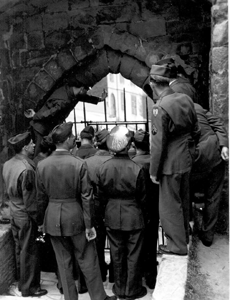
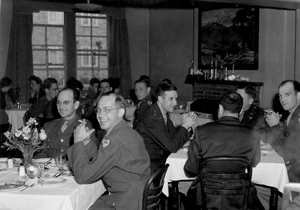
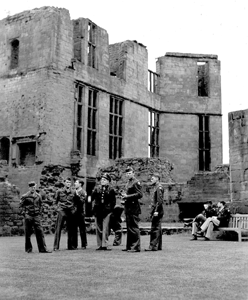
The 1455th Ordnance Company at work and play - Below left: A member of the company running a lathe in the workshop Below centre: Richard 'Dick' Gardner (centre) relaxing whilst off duty. Below right: 'Dick' Gardner (far right) enjoying a drink at a GI Beer Party. (All pictures Mrs C. Aston)
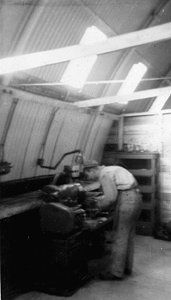
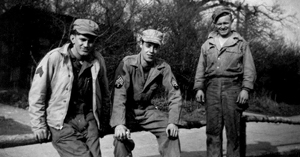
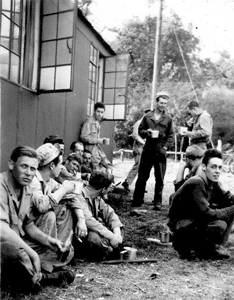
Below: The baseball field at Ramsbury (Mrs C. Aston)
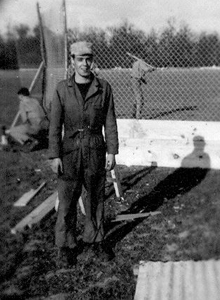
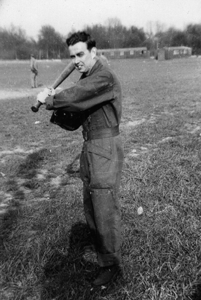
Can You Help?
The following pictures were sent by Mr Louis Zenti and show his Grandfather George H. Romanelli who was a radio operator with the 86th Squadron. Mr Zenti is anxious to correspond with anybody who served with his Grandfather during WWII and can be contacted at: centralwire@mcleodusa.net
Below left: George Romanelli at the school for pilots in the USA. Unfortunately he found that piloting aircraft was not to his liking and transferred to radio school in Sioux Falls, South Dakota, where the second picture (Below right) was taken. George is on the extreme left.
